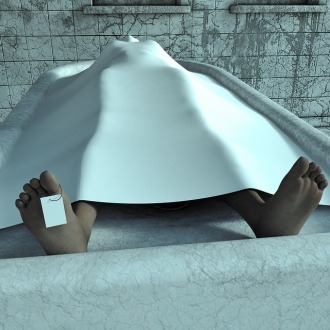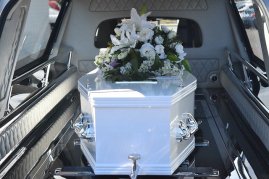Mystery authors deal in death. They must get the details correct when writing about the untimely demise of a character. Because laws for responding to death vary by location in  the United States, authors have to do research depending on their setting. Without a national standard, each state and frequently each county within a state sets its own rules for handling unexpected deaths. In January, Sisters in Crime: Heart of Texas Chapter was fortunate to have Tiffany Cooper-Aguilar, a licensed funeral director and embalmer, walk authors through the legalities of collecting, handling, and storing bodies after death in small town Texas.
the United States, authors have to do research depending on their setting. Without a national standard, each state and frequently each county within a state sets its own rules for handling unexpected deaths. In January, Sisters in Crime: Heart of Texas Chapter was fortunate to have Tiffany Cooper-Aguilar, a licensed funeral director and embalmer, walk authors through the legalities of collecting, handling, and storing bodies after death in small town Texas.
In Texas, the handling of medically unattended deaths varies by county population. Larger, more populous counties are required by law to have a medical examiner’s (ME) office. The ME’s office collects the bodies of those who die outside of a medical facility,  and the medical examiner determines the cause of death. Less populous counties aren’t legally required to have medical examiner’s offices. They rely on contracted mortuary services or funeral homes to collect the bodies of the dead. Lacking a medical examiner, these counties rely on a justice of the peace to decide if a cause of death is apparent or if a body should be sent for an autopsy to determine the cause of death.
and the medical examiner determines the cause of death. Less populous counties aren’t legally required to have medical examiner’s offices. They rely on contracted mortuary services or funeral homes to collect the bodies of the dead. Lacking a medical examiner, these counties rely on a justice of the peace to decide if a cause of death is apparent or if a body should be sent for an autopsy to determine the cause of death.
According to Ms. Cooper-Aguilar, in central Texas alone, laws and practices vary considerably by county. Some counties may have a single funeral home contracted to retrieve all bodies. Other counties may have several funeral homes contracted on a rotational basis. One county is even known to force family members to choose a funeral home as soon as a death is discovered to prevent the county from expending the funds needed to transport and store the body. Still other counties may use a mortuary service, which is a small company created specifically for collecting and storing the dead temporarily until a decision is made to either send the body to an autopsy or to send it to a funeral home for burial.
In counties where a funeral home is contracted, a licensed funeral director and one assistant director will go to the scene of the death to remove a body. Fire, EMS, and law  enforcement personnel in less populous counties leave the body where it is discovered, so that the funeral director and assistant have to go into water, fields, ditches, wrecked cars, or other locations to retrieve the decedent.
enforcement personnel in less populous counties leave the body where it is discovered, so that the funeral director and assistant have to go into water, fields, ditches, wrecked cars, or other locations to retrieve the decedent.
Depending on weight, the state of decomposition, rigor mortis, and traumatic injury, the funeral home employees may need a variety of items to collect a body. Ms. Cooper-Aguilar states that a plain white sheet is her best tool in these situations. A sheet can be knotted for gripping, is an aid in unwedging bodies in awkward locations, and is perfect for ensuring that the entire body stays together during removal.
In most cases the funeral home or mortuary services personnel will wrap the body in the white sheet first. Some counties, but not all, require the remains also be placed in a zip-tied body bag. The body is then transported to refrigerated storage until the justice of the peace’s official paperwork is completed determining the next steps in the process. During this storage time, the deceased remains untouched until the legal formalities are settled. Family is not allowed access to the body during this period.
 The justice of the peace orders autopsies when the cause of death is unknown or questionable. If an autopsy is required, the body will be transported to the medical practitioner responsible for carrying out the autopsy. Small counties may contract with larger counties to use their medical examiner for autopsies. After the autopsy is complete and the body is released for burial, the legal next of kin must sign a release allowing a funeral home to collect the remains from the medical examiner and prepare them for burial or cremation.
The justice of the peace orders autopsies when the cause of death is unknown or questionable. If an autopsy is required, the body will be transported to the medical practitioner responsible for carrying out the autopsy. Small counties may contract with larger counties to use their medical examiner for autopsies. After the autopsy is complete and the body is released for burial, the legal next of kin must sign a release allowing a funeral home to collect the remains from the medical examiner and prepare them for burial or cremation.
If no autopsy is ordered, the deceased is released for burial and the next of kin may choose funerary services with any funeral home. The decedent may be transferred between funeral homes at the family’s request.
 Burial may take place as soon as the family is ready. Texas law does not require embalming to occur before burial. Cremation, however, requires additional legal paperwork which can take up to two weeks to be completed. While reducing human remains to ash can be accomplished in a matter of hours, acquiring the paperwork needed to begin the process takes time. Getting authorization for cremation is a longer process because a buried body can be dug up and studied if foul play is suspected at a later date, a cremated one can’t.
Burial may take place as soon as the family is ready. Texas law does not require embalming to occur before burial. Cremation, however, requires additional legal paperwork which can take up to two weeks to be completed. While reducing human remains to ash can be accomplished in a matter of hours, acquiring the paperwork needed to begin the process takes time. Getting authorization for cremation is a longer process because a buried body can be dug up and studied if foul play is suspected at a later date, a cremated one can’t.
Ms. Cooper-Aguilar provided highly detailed information about the legal handling of unexpected death in counties with small populations in Texas. She explained the steps required to prepare a body for identification by family and the entire embalming process, including discussing how the embalmer deals with a body from which tissues, organs, or bones have been donated. Ms. Cooper-Aguilar answered many questions from the audience, providing a thorough overview of the legal handling of death in small town Texas.
*****
All pictures provided by Pixabay.
N. M. Cedeño is a short story writer and novelist living in Texas. She is currently working on a series called Bad Vibes Removal Services. The second novel in the series, entitled Degrees of Deceit, came out in August 2019. Ms. Cedeño is currently the president of Sisters in Crime- Heart of Texas Chapter.
